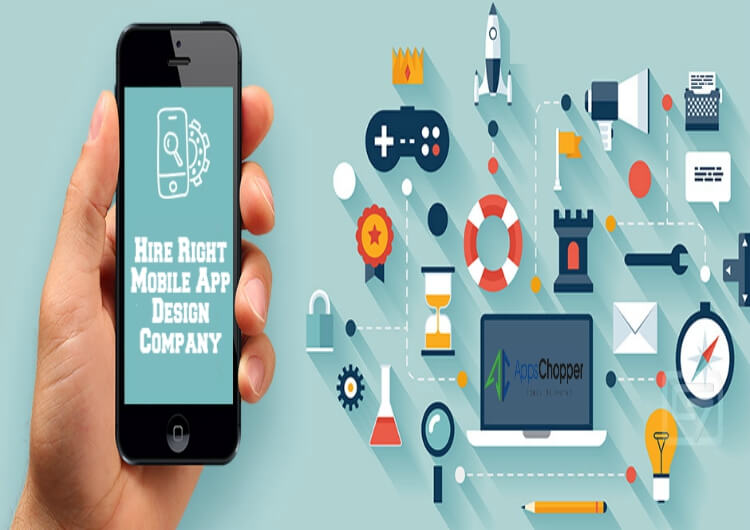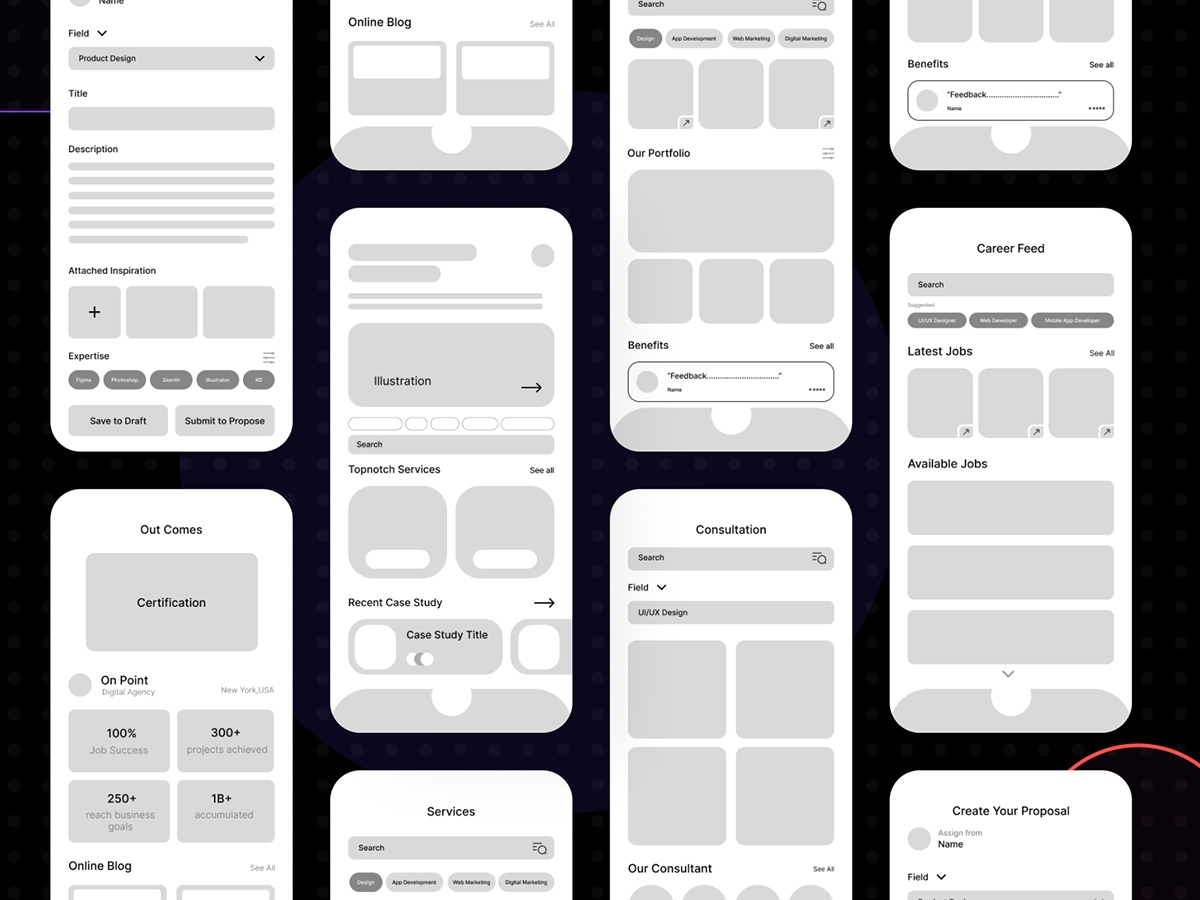In today’s digital age, a captivating mobile app is crucial for businesses to thrive. A skilled mobile app design agency plays a pivotal role in this digital transformation. From conceptualization to launch, these agencies guide the creation of innovative and user-friendly apps that resonate with target audiences. They leverage cutting-edge design principles, ensuring seamless user experiences that ultimately drive app success.
This comprehensive guide explores the multifaceted world of mobile app design agencies, examining their key services, collaborative strategies, and the evolving trends shaping the industry. It provides actionable insights into evaluating agencies, measuring success, and understanding the future trajectory of mobile app design.
Introduction to Mobile App Design Agencies

Mobile app design agencies are the unsung heroes of the digital age. They’re the architects of the experiences we have on our phones, transforming raw ideas into polished, intuitive applications that captivate users. Their role extends far beyond just creating aesthetically pleasing interfaces; it’s about crafting seamless interactions that resonate with the user on a deep level, fostering engagement and driving conversions.
These agencies are the bridge between a concept and a successful, user-friendly application. They understand the intricacies of the mobile landscape, from the latest operating systems to the evolving user expectations. They’re adept at navigating the complexities of development, ensuring the application not only looks good but also performs flawlessly on a multitude of devices.
The Role of Mobile App Design Agencies
Mobile app design agencies play a critical role in the digital ecosystem. They act as strategic partners, helping businesses translate their visions into tangible, engaging applications. They possess a deep understanding of the target audience, the latest design trends, and the technical intricacies of mobile development. Their expertise spans the entire app lifecycle, from initial concept to final deployment.
Services Typically Offered
A comprehensive range of services is typically offered by a mobile app design agency. These include: market research and analysis, user experience (UX) design, user interface (UI) design, wireframing and prototyping, front-end and back-end development, testing and quality assurance, app store optimization (ASO), and ongoing maintenance and support. This holistic approach ensures a smooth transition from idea to launch and beyond.
The Importance of UX and UI Design
User experience (UX) and user interface (UI) design are paramount in the success of any mobile application. A well-designed UX ensures that the application is intuitive and easy to navigate. A visually appealing and well-structured UI enhances the user’s overall experience. This combination fosters user engagement and drives positive user feedback. A seamless user journey is critical for retention and positive word-of-mouth.
Contribution to Successful App Launches
Mobile app design agencies are instrumental in successful app launches. They bring a wealth of knowledge, experience, and a focused approach that elevates the chances of a positive user experience and increased app downloads. They ensure that the app is not only technically sound but also aligns with the brand identity and caters to the target audience.
Example Agencies and Their Projects
| Agency Name | Specializations | Key Client Projects |
|---|---|---|
| AppZen | UX/UI design, mobile app development, AR/VR integration | “FitnessFusion” (fitness tracking app), “ArtConnect” (social art platform), “EcoTracker” (sustainable living app) |
| PixelPerfect Studios | Mobile game development, e-commerce app development, custom software solutions | “QuestRunner” (popular mobile game), “ShopSmart” (online retail app), “ProFile” (business management software) |
| InnovateApps | Financial app development, healthcare app development, education app development | “SmartInvest” (investment tracking app), “MediConnect” (doctor-patient communication app), “LearnPro” (interactive learning platform) |
Key Services Offered by Mobile App Design Agencies

Crafting a mobile app is more than just lines of code; it’s about weaving a digital experience that resonates with users. Mobile app design agencies understand this, offering a spectrum of services to bring your vision to life, from the initial spark of an idea to the polished final product. They act as trusted partners, guiding you through the complexities of the mobile landscape.
A successful mobile app is a symphony of meticulous design, insightful user research, and a deep understanding of technology. These agencies are the conductors, orchestrating all the elements to create a harmonious and engaging user experience. They provide a vital bridge between your business goals and the digital world.
Types of Mobile App Design Services
Mobile app design agencies offer a diverse range of services, tailored to meet specific needs. These services can include everything from initial concept development and user interface (UI) design to back-end development and ongoing maintenance. Each phase requires meticulous attention to detail and a deep understanding of the platform’s nuances.
- Concept Development & Strategy: This initial phase involves brainstorming, ideation, and market analysis. The agency helps define the app’s purpose, target audience, and overall value proposition. A well-defined concept is crucial for success. This often involves workshops and presentations to ensure alignment with the client’s vision.
- User Interface (UI) & User Experience (UX) Design: UI design focuses on the visual aspects of the app, while UX design focuses on the overall user journey. Agencies leverage industry best practices and user-centered design principles to craft an intuitive and aesthetically pleasing interface. They consider factors like navigation, information architecture, and accessibility. High-fidelity prototypes are frequently created to showcase the user experience.
- Mobile App Development: This involves translating the design into functional code. Agencies specialize in various mobile platforms (iOS, Android, cross-platform) using appropriate frameworks and technologies. This crucial step ensures the app performs flawlessly across different devices and operating systems.
- Testing & Quality Assurance: Rigorous testing is paramount to ensure the app functions as intended. This includes various testing methodologies like usability testing, performance testing, and security testing to identify and resolve potential issues. A bug-free app is a reliable app.
- Maintenance & Updates: Ongoing maintenance is essential for addressing bugs, implementing updates, and ensuring the app remains relevant and functional over time. Regular updates keep the app current with user needs and security protocols.
User Research and Analysis in App Design
Understanding the target audience is critical to crafting a successful app. Thorough user research and analysis provide valuable insights into user needs, behaviors, and preferences. This understanding is vital in shaping the app’s design and functionality.
- User Interviews: Gathering direct feedback from potential users through interviews helps uncover pain points and opportunities. Qualitative data provides insights into user motivations and expectations.
- Surveys: Quantitative data from surveys helps identify trends and preferences in a larger user base. This can inform design decisions and prioritize features.
- Usability Testing: Observing users interacting with prototypes helps identify usability issues and refine the design process. This iterative process ensures the app is intuitive and easy to use.
Prototyping and Testing in Mobile App Development
Prototyping and testing are essential for evaluating the user experience and functionality of an app. Prototypes serve as interactive representations of the app, allowing for early feedback and iteration. Testing reveals areas for improvement before significant development investment.
- Low-Fidelity Prototypes: These initial prototypes help visualize the core features and navigation flow of the app. They are less detailed but offer a quick way to assess basic functionality and user flow.
- High-Fidelity Prototypes: These detailed prototypes allow for more realistic user interaction and testing. They mimic the final app design, providing a more comprehensive understanding of the user experience.
- A/B Testing: This method involves testing different design variations to determine which performs best with users. It can identify effective solutions for usability issues and improve conversion rates.
Mobile App Development Platforms (iOS, Android, Cross-Platform)
Choosing the right platform is crucial for app development. iOS and Android represent distinct platforms with their own requirements and development tools. Cross-platform development offers a balance between cost and time.
- iOS Development: Leveraging Swift or Objective-C, iOS development targets Apple devices. This platform offers a specific design language and user experience.
- Android Development: Using Java or Kotlin, Android development targets Google’s Android operating system. It offers wider device compatibility.
- Cross-Platform Development: Frameworks like React Native or Flutter enable development for multiple platforms using a single codebase. This approach offers faster development cycles.
Service Cost and Timeline
The cost and timeline for mobile app development vary significantly based on complexity, features, and platform. A clear understanding of these factors is crucial for accurate budgeting.
| Service | Description | Cost (Estimated) | Typical Timeline |
|---|---|---|---|
| Concept Development & Strategy | Ideation, market analysis, and defining app purpose. | $5,000 – $20,000 | 2-4 weeks |
| UI/UX Design | Visual design and user experience strategy. | $5,000 – $30,000+ | 2-6 weeks |
| App Development (iOS) | Development for Apple devices. | $10,000 – $50,000+ | 4-12 weeks |
| App Development (Android) | Development for Android devices. | $10,000 – $50,000+ | 4-12 weeks |
| Cross-Platform Development | Development for multiple platforms using a single codebase. | $8,000 – $40,000+ | 6-15 weeks |
Client Collaboration and Project Management
Building a mobile app is a collaborative journey, a dance between client vision and agency expertise. Trust and open communication are the cornerstones of a successful partnership. This shared understanding fosters innovation and ensures the final product resonates deeply with the client’s aspirations.
Effective communication, meticulous project management, and clear expectations are vital for a seamless and fulfilling experience for both parties. A strong foundation built on these principles ensures the project progresses smoothly and the final app exceeds expectations.
Effective Communication Strategies
Clear and consistent communication channels are paramount. Regular updates, whether through dedicated project management software, email, or video calls, keep everyone informed and aligned. Using a shared platform for document storage and version control minimizes confusion and ensures everyone is working with the most current information. Active listening, both from the agency to the client and vice versa, helps identify potential roadblocks early and ensures all concerns are addressed. A collaborative approach, where both parties actively participate in the conversation, is essential for a productive relationship.
Project Timeline and Budget Management
Managing project timelines and budgets requires a proactive and transparent approach. Detailed project timelines, outlining milestones and deadlines, are crucial. These timelines should be reviewed and agreed upon with the client, ensuring realistic expectations are set. A well-defined budget, encompassing all project costs (design, development, testing, marketing, etc.), is essential. Regular budget reviews help identify any potential cost overruns and allow for proactive adjustments.
Importance of Clear Project Specifications and Deliverables
Clear project specifications are the blueprint for a successful mobile app. These specifications should Artikel the app’s features, functionality, target audience, and design principles. This detailed document serves as a shared understanding, ensuring everyone is on the same page. Defining clear deliverables, including specific design mockups, functional prototypes, and the final app, prevents ambiguity and misunderstandings.
Conflict Resolution Strategies
Conflicts in client-agency relationships are inevitable, but proactive conflict resolution strategies can mitigate their impact. Establishing clear communication channels, and maintaining a respectful and professional tone, are essential. Constructive feedback, actively listening to concerns, and a willingness to find mutually agreeable solutions can resolve conflicts effectively. A commitment to finding solutions collaboratively, rather than focusing on blame, is key.
Potential Challenges in App Design Projects and Their Solutions
- Evolving Client Requirements: Client needs often change during the development process. Staying flexible and adaptable, while maintaining clear communication, is crucial. Regular check-ins and iterative design cycles can accommodate changes effectively. This allows for incorporating feedback and refining the app based on evolving client priorities.
- Technical Limitations: Technical constraints, such as device compatibility or platform limitations, can affect the app’s functionality. Addressing these limitations proactively through thorough research, detailed planning, and open communication with the client is vital. This ensures the final app is as functional and accessible as possible, while remaining within the technical boundaries.
- Budget Constraints: Budget constraints can limit the scope of the project. Finding ways to balance the client’s needs with the budget is crucial. This involves prioritizing features, exploring cost-effective solutions, and clearly outlining the implications of any budget adjustments.
- Communication Gaps: Misunderstandings or misinterpretations between client and agency can hinder progress. Clear communication channels and regular check-ins can reduce the likelihood of these gaps. Using visual aids and documentation ensures that everyone is on the same page.
Trends and Innovations in Mobile App Design

The mobile app landscape is constantly evolving, driven by the relentless pursuit of user experience and technological advancements. This dynamic environment necessitates a keen understanding of emerging trends to craft compelling and impactful applications. Designers and developers must adapt to these shifts to create apps that not only meet current user expectations but also anticipate future needs.
Innovative mobile app design is no longer simply about aesthetics; it’s about seamless integration with users’ lives, offering intuitive interactions, and leveraging the full potential of emerging technologies. This evolution demands a deep understanding of user psychology, a forward-thinking approach to design, and a commitment to continuous improvement.
Emerging Trends in Mobile App Design
The mobile app design world is brimming with fresh ideas. From immersive experiences to personalized interfaces, these trends redefine how users interact with their devices. A key trend is the rise of augmented reality (AR) and virtual reality (VR) integration. These technologies are reshaping the way users engage with applications, offering interactive and engaging experiences. Imagine trying on clothes virtually before purchasing or exploring historical sites through a VR lens.
Influence of New Technologies on App Design
New technologies are fundamentally altering the design and development of mobile applications. The increasing power of mobile devices, coupled with advancements in cloud computing and machine learning, unlocks unprecedented possibilities. Developers are using these tools to create more powerful and sophisticated apps that are seamlessly integrated into users’ daily routines.
Impact of AI and Machine Learning on Mobile App Design
Artificial intelligence (AI) and machine learning (ML) are transforming the mobile app design landscape. AI-powered features like personalized recommendations, predictive maintenance, and automated customer service are becoming increasingly prevalent. Imagine an app that anticipates your needs before you even realize them, or a customer service chatbot that can resolve issues instantly. These advancements are reshaping the user experience and pushing the boundaries of what’s possible.
Innovative Mobile App Design Solutions
Numerous innovative mobile app design solutions are emerging to meet evolving user needs. One notable example is the integration of biometrics for enhanced security and user authentication. Another trend involves the development of apps that leverage location services to provide contextual information and personalized experiences. For example, a fitness app that suggests nearby parks based on your current location or a navigation app that offers personalized route recommendations based on your preferences. These examples showcase the creative use of technology to enhance user experiences.
Comparison of App Design Trends
| Trend | Benefits | Drawbacks |
|---|---|---|
| Augmented Reality (AR) | Enhanced user engagement, interactive experiences, new ways to interact with digital content | Requires specialized hardware, potential for motion sickness, and high development costs |
| Virtual Reality (VR) | Immersive experiences, interactive training and educational applications | Requires specialized headsets, potential for motion sickness, and high development costs |
| AI-Powered Personalization | Improved user experience, increased customer engagement, higher conversion rates | Data privacy concerns, potential for bias in algorithms, need for constant data updates |
| Biometric Authentication | Enhanced security, user convenience, reduced reliance on passwords | Potential for system vulnerabilities, user concerns regarding privacy, and cost of implementing new security features |
The table above provides a glimpse into the advantages and disadvantages of different emerging app design trends. A careful consideration of both sides is critical when evaluating the suitability of a particular trend for a given project.
Evaluating Mobile App Design Agencies

Choosing the right mobile app design agency is crucial for the success of your project. It’s a partnership that demands careful consideration, not just a quick search. This stage isn’t about finding the cheapest option, but the best fit for your vision, your team, and your ultimate goals. Trust your instincts, and delve deep into the process.
Finding the ideal agency is more than just picking a name; it’s about understanding their capabilities and their commitment to your project. It’s about aligning their expertise with your unique needs and ensuring a collaborative journey that culminates in a breathtaking app.
Key Factors to Consider When Choosing an Agency
Selecting a mobile app design agency involves evaluating a range of factors beyond aesthetics. A truly effective agency possesses a deep understanding of the mobile landscape, a strong design philosophy, and a robust project management system. These factors ensure a seamless, efficient, and rewarding experience.
- Technical Expertise: Agencies should possess a strong foundation in mobile technologies, including proficiency in various programming languages (e.g., Swift, Kotlin), frameworks (e.g., React Native, Flutter), and development platforms (iOS, Android). This ensures your app is built with the right tools and the latest industry standards.
- Design Philosophy and Aesthetics: A well-defined design philosophy, paired with a strong understanding of current trends, is critical. A successful agency will bring their creative flair to the table, but also listen to your vision and translate it into a compelling user experience.
- Project Management Processes: An efficient and transparent project management system ensures clear communication, timely updates, and a streamlined development process. This includes well-defined milestones, consistent communication channels, and an adaptable approach to address any challenges that may arise.
Assessing Agency Expertise and Experience
A thorough evaluation of an agency’s expertise and experience goes beyond looking at a website. It involves digging into their past projects, their team members, and their approach to problem-solving.
- Portfolio Review: A strong portfolio showcases a range of projects, highlighting the agency’s versatility and ability to tackle diverse challenges. Look for a portfolio that aligns with your app’s goals and target audience. Assess not just the visual design but also the functionality and technical aspects of each project. Pay close attention to reviews and testimonials from previous clients.
- Case Studies: Deep dive into the agency’s case studies. These provide detailed insights into their approach, challenges faced, and solutions implemented. This is where you’ll gain a better understanding of their problem-solving skills and their ability to handle various complexities. Look for case studies that directly address your app’s target market and platform.
- Team Profiles: Understand the experience and expertise of the team members. A team with diverse skill sets, and experience in app development, UI/UX design, and project management can significantly improve the chances of success.
Evaluating Communication and Project Management
Clear communication and efficient project management are paramount for a successful app development journey. A transparent agency will proactively address questions and concerns, keeping you informed throughout the process.
- Communication Channels and Frequency: A good agency maintains open and consistent communication, utilizing multiple channels (e.g., email, project management tools) to ensure you’re always in the loop. This should be tailored to your preferences and availability.
- Response Times and Problem-Solving: Assess the agency’s responsiveness to your inquiries and their ability to address potential problems effectively. A responsive team can quickly address issues, maintaining the project’s momentum.
- Project Management Tools and Techniques: Look for agencies that use robust project management tools. A well-structured approach will facilitate clear communication and efficient task management. This leads to a more productive and streamlined development process.
Agency Comparison Table
This table provides a framework for comparing different mobile app design agencies based on their strengths and weaknesses.
| Agency | Strengths | Weaknesses |
|---|---|---|
| Agency A | Strong portfolio in gaming apps, experienced team, transparent communication | Limited experience with e-commerce apps, slightly slower response times |
| Agency B | Excellent UI/UX design, fast turnaround times, proven expertise in SaaS apps | Less experience with complex technical integrations, occasional communication hiccups |
| Agency C | Proven track record in education apps, excellent project management skills, great team collaboration | Higher pricing compared to other agencies, less experience with mobile games |
Success Metrics for Mobile App Design Agencies
Crafting a successful mobile app is more than just aesthetics; it’s a journey of user engagement, satisfaction, and sustained use. A mobile app design agency’s success hinges on its ability to deliver apps that resonate with users, driving significant downloads, active engagement, and ultimately, a positive return on investment. This involves a deep understanding of the metrics that truly matter.
Measuring the success of a mobile application is multifaceted. It’s not just about the number of downloads, but the depth of user interaction and the long-term value the app brings. We need to delve into the specifics of user engagement, app performance, and user satisfaction to truly gauge the success of the app and, consequently, the agency.
Key Metrics for Measuring User Engagement
User engagement is the lifeblood of any successful mobile application. It demonstrates how actively users interact with the app and how deeply it’s integrated into their daily lives. Understanding this crucial metric provides insight into the app’s overall health and potential. This requires careful monitoring and analysis of user behaviors. Key indicators include the frequency and duration of app usage, the number of daily active users (DAU), weekly active users (WAU), and monthly active users (MAU). These figures provide a clear picture of the app’s popularity and its ability to retain users over time.
- Daily Active Users (DAU): The number of unique users who have interacted with the app on a given day. A high DAU signifies a robust user base actively engaging with the app’s features.
- Weekly Active Users (WAU): The number of unique users who have interacted with the app within a week. This metric reveals the app’s ability to retain users over longer periods.
- Monthly Active Users (MAU): The number of unique users who have interacted with the app within a month. This provides a broader view of the app’s user base and long-term engagement.
- Session Duration: The average time a user spends in the app during a single session. A longer session duration suggests users find the app engaging and valuable.
- Feature Usage: The frequency and depth of usage for different app features. Understanding which features are most popular and which are underutilized helps refine the app and improve its value proposition.
App Performance Metrics
App performance directly impacts user experience and ultimately, the success of the app. A slow or unstable app can quickly deter users, leading to lower engagement and retention. Optimizing app performance is crucial for long-term success. Metrics to consider include app loading time, crash rates, and battery consumption.
- App Loading Time: The time it takes for the app to load and become functional. Fast loading times are critical for maintaining user interest and preventing frustration.
- Crash Rate: The frequency with which the app crashes. Minimizing crashes is essential to maintain user trust and prevent lost progress or data.
- Battery Consumption: The amount of battery power the app consumes. Efficient battery usage is crucial, especially for mobile users on the go.
- App Store Ratings and Reviews: User feedback provides valuable insights into the app’s performance and user experience. Tracking ratings and reviews can highlight areas needing improvement.
User Satisfaction and Retention Metrics
User satisfaction is crucial for long-term app success. High satisfaction translates into positive reviews, word-of-mouth referrals, and ultimately, increased user retention. Retention metrics track how long users continue to engage with the app. Understanding user satisfaction and retention rates allows for proactive improvements to the user experience.
- User Satisfaction Score (SUS): A standardized metric used to measure user satisfaction. High SUS scores indicate a positive user experience.
- Net Promoter Score (NPS): Measures customer loyalty and willingness to recommend the app. A high NPS signifies strong customer loyalty and positive word-of-mouth marketing.
- Churn Rate: The percentage of users who stop using the app within a given period. A low churn rate indicates strong user retention.
- User Reviews and Ratings: Direct feedback from users about their experience with the app. Monitoring these can highlight areas of improvement and user pain points.
Strategies for Optimizing App Performance and User Experience
Optimization strategies focus on improving app performance and delivering an exceptional user experience. By continuously refining the app based on user feedback and performance data, agencies can ensure sustained success.
- A/B Testing: Testing different versions of the app to identify which performs best and improves user engagement.
- Regular Performance Monitoring: Continuously tracking key metrics like app loading time and crash rates to identify and address issues.
- User Feedback Incorporation: Actively gathering and responding to user feedback to enhance the app’s features and address user concerns.
- App Store Optimization (ASO): Improving app visibility in app stores to attract a wider audience and increase downloads.
Target Metrics for Successful App Development
| Metric | Target Value (Example) |
|---|---|
| Daily Active Users (DAU) | 10,000+ |
| Weekly Active Users (WAU) | 15,000+ |
| Monthly Active Users (MAU) | 30,000+ |
| App Loading Time | Less than 2 seconds |
| Crash Rate | Less than 0.5% |
| User Satisfaction Score (SUS) | 80+ |
| Net Promoter Score (NPS) | 70+ |
The Future of Mobile App Design Agencies

The mobile app design landscape is a dynamic realm, constantly evolving with technological advancements and shifting user expectations. Mobile app design agencies are at the heart of this evolution, tasked with not only crafting visually appealing and functional apps but also anticipating the future of mobile experiences. This future is brimming with both exciting opportunities and unforeseen challenges, demanding a profound adaptability and forward-thinking approach from these agencies.
The future of mobile app design agencies hinges on their ability to embrace change and leverage emerging technologies. This requires a commitment to continuous learning, a willingness to experiment with new tools and techniques, and a deep understanding of user behavior trends. Successful agencies will be those who not only create beautiful apps but also anticipate and respond to the needs of their clients and the ever-changing digital world.
Potential Market Disruptions and Opportunities
The mobile app market is not immune to disruptive forces. The rise of AI-powered tools and augmented reality (AR) applications is reshaping how users interact with their devices. This presents both challenges and lucrative opportunities for design agencies. Embracing AI for automating tasks like prototyping or generating design assets can free up designers to focus on the more creative and strategic aspects of app development. Agencies that integrate AR capabilities into their services will gain a significant edge in developing immersive and interactive applications. This includes exploring the use of AI for generating unique and engaging app designs and features, and for personalizing user experiences.
Adaptability and Innovation in Mobile App Design
Staying ahead in this competitive market necessitates a commitment to adaptability and innovation. Mobile app design agencies must continuously explore new technologies, update their skill sets, and adapt their processes to remain relevant. This includes learning new programming languages, mastering emerging design trends, and understanding how to integrate AI and AR effectively into applications. By embracing a culture of innovation, these agencies can cultivate a forward-thinking approach and empower their clients to stay ahead of the curve.
Predictions for the Evolution of Mobile App Design and Development
The next five years promise a significant evolution in mobile app design. We anticipate a greater emphasis on personalization, seamless user experiences, and intuitive navigation. Apps will increasingly incorporate AI-powered features, offering tailored recommendations, proactive assistance, and dynamic content updates. This trend reflects the growing demand for customized and intelligent applications that anticipate user needs and deliver exceptional value. Furthermore, the integration of virtual reality (VR) and augmented reality (AR) technologies will become more commonplace, enabling more immersive and interactive mobile experiences. The future is undoubtedly more interconnected and personalized, demanding a greater understanding of the user journey.
Predicted Advancements in Mobile App Design (Next 5 Years)
| Advancement | Description | Impact on Agencies |
|---|---|---|
| AI-Driven Personalization | Apps will use AI to understand user preferences and deliver tailored content, features, and recommendations. | Agencies need to adopt AI tools and understand user data analysis. |
| AR/VR Integration | Immersive experiences through augmented and virtual reality will become more common in mobile apps. | Agencies must learn AR/VR development techniques to offer enhanced services. |
| Enhanced User Interface (UI) Design | Focus on intuitive and seamless navigation, creating user-friendly interfaces, will continue to evolve. | Agencies must continuously explore new UI/UX design trends and adapt their processes. |
| Serverless Architecture | Cloud-based architecture will reduce infrastructure costs and improve app performance. | Agencies need to understand serverless architecture and cloud services. |
| Blockchain Integration | Applications integrating blockchain for secure transactions and data management will increase. | Agencies must explore blockchain development and security aspects. |
Outcome Summary
In conclusion, mobile app design agencies are indispensable partners in the app development journey. Their expertise in design, user experience, and project management empowers businesses to launch impactful applications. By understanding the key services, collaboration strategies, and emerging trends, businesses can confidently select the right agency to propel their app to success. Ultimately, a well-designed app translates to a stronger brand presence, increased user engagement, and significant business growth.





